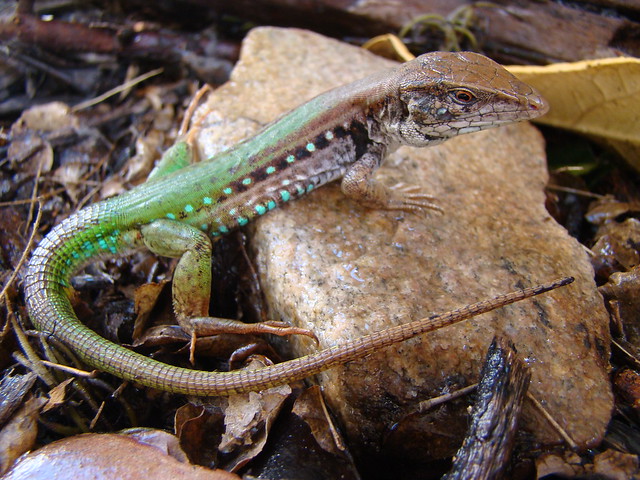Post by Ceratodromeus on Jun 2, 2015 1:12:47 GMT 5

Scientific classification:
Kingdom: Animalia
Phylum: Chordata
Class: Reptilia
Order: Squamata
Suborder: Sauria
Family: Teiidae
Genus: Cnemidophorus
Species: C. ocellifer
Description: C. ocellifer is a small, brilliantly colored Teiid lizard. Coloration tends to be a rustic red or brown, with shades of green, red, yellow, and even blue(depending on sex and age of the animal).They are sexually dimorphic, with males attaining larger sizes then the females(Though this is not present in a significant degree), and posessing proportionally larger heads. Healthy adult individuals of the species average 60-70mm(2.3-2.7in) SVL, though some can grow upwards of 90mm(3.5in) SVL. Weights for the species range from 2-13g in adults(See below).

reference for image: {1}
Geographic range: This lizard can be found throughout South America, ranging from Argentina to Brazil.
Dietary habits: This lizard is insectivorious, feeding on a variety of invertebrates. Studies have shown this lizard primarily feeds on members of Orthroptera(Grasshoppers, cricket, katydids) and termites[See below]).In some locations, Insect larvae make up a significant portion(upwards of 50%) of C. ocellifer's diet.{3} On some occasions, lizards, scorpions and small mammals(Mus) are taken.{2} Spix's whiptail is an active forager, spending most of its day rooting through forest floor in search of food.

Reference for image: {1}
Reproduction: Sexually mature female individuals of C. ocellifer average 57.6mm(2.2in) SVL, while males average 59.2(2.3in) SVL. The reproductive season Is September-January, with eggs being laid in October-November. Clutch sizes is rather small, ranging from 2-4 eggs. The incubation period lasts 60 days. When the young hatch they go through rapid growth, attaining adult size by the end of their first year.{4}
References:
{1} Santana, G. G., et al. "Feeding habits, sexual dimorphism and size at maturity of the lizard Cnemidophorus ocellifer (Spix, 1825)(Teiidae) in a reforested restinga habitat in northeastern Brazil." Brazilian Journal of Biology 70.2 (2010): 409-416.
{2} Sales, Raul FD, et al. "Feeding habits and predator-prey size relationships in the whiptail lizard Cnemidophorus ocellifer (Teiidae) in the semiarid region of Brazil." south American Journal of herpetology 7.2 (2012): 149-156.
{3}Oliveira Mesquita, Daniel, and Guarino Rinaldi Colli. "The ecology of Cnemidophorus ocellifer (Squamata, Teiidae) in a neotropical savanna." Journal of Herpetology 37.3 (2003): 498-509.
{4} Cruz, Félix B. "Reproductive biology of the lizard Cnemidophorus ocellifer in the dry chaco of Salta, Argentina".


